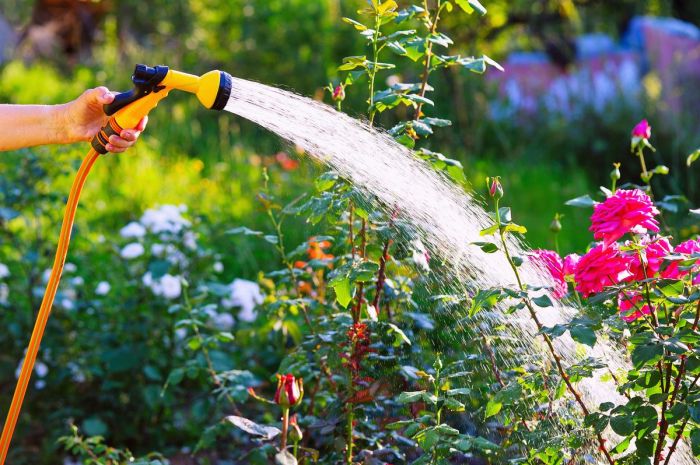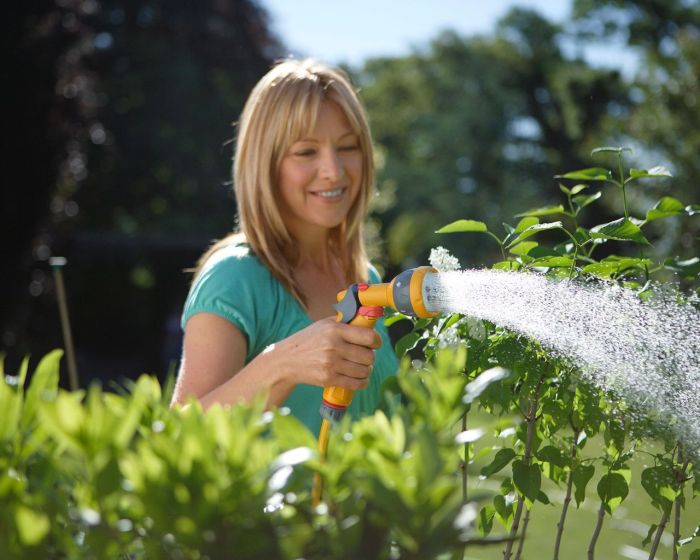When to Water Outdoor Plants
Understanding Your Plants’ Water Needs
When to water outdoor plants – Providing your outdoor plants with the right amount of water is crucial for their health and vitality. Several factors influence a plant’s water requirements, and understanding these factors is key to successful gardening. This section will explore these factors and provide guidance on determining the specific needs of different plant types.
Factors Influencing Plant Water Requirements
Several key factors determine how much water your plants need. These include sun exposure, soil type, plant type, and climate. Plants in full sun will dry out faster than those in shade, requiring more frequent watering. Well-draining soil allows excess water to escape, preventing root rot, while heavy clay soils retain more moisture, reducing the need for frequent watering.
Different plant types have different water requirements; succulents, for example, are adapted to arid conditions and require less frequent watering than thirsty flowering plants. Finally, climate significantly impacts watering needs; hot, dry climates demand more frequent watering than cool, humid ones.
Water Needs of Different Plant Types
The table below summarizes the water needs of various common plant types. Remember that these are general guidelines; individual plant needs can vary depending on the specific variety, growing conditions, and time of year.
| Plant Type | Sunlight Preference | Soil Type | Watering Frequency |
|---|---|---|---|
| Succulents | Full sun to partial shade | Well-draining | Infrequent, allow soil to dry completely between waterings |
| Herbs (Basil, Rosemary, etc.) | Full sun | Well-draining | Regular, keep soil consistently moist but not soggy |
| Flowering Plants (Roses, Petunias, etc.) | Varies by species | Well-draining, fertile | Regular to frequent, depending on sun exposure and soil type |
| Vegetables (Tomatoes, Peppers, etc.) | Full sun | Well-draining, fertile | Regular, maintain consistently moist soil |
Identifying Signs of Underwatering and Overwatering
Recognizing signs of underwatering and overwatering is essential for maintaining healthy plants. Underwatered plants may exhibit wilting, leaf drop, and stunted growth. Overwatered plants, on the other hand, may show yellowing leaves, root rot (indicated by a foul odor emanating from the soil), and mushy stems. These symptoms can vary depending on the plant type. For example, succulents might shrivel and become wrinkled when underwatered, while overwatering might cause them to become soft and prone to rot.
Herbs may wilt quickly if underwatered but develop yellowing lower leaves if overwatered. Flowering plants might show wilting and flower drop if underwatered, while overwatering can lead to fungal diseases.
Checking Soil Moisture
Accurately assessing soil moisture is crucial for effective watering. Several methods can be employed, each with its advantages and limitations.
Methods for Assessing Soil Moisture
The finger test, moisture meter, and visual inspection are three common methods used to check soil moisture. The finger test involves inserting your finger about an inch into the soil. If the soil feels dry, it’s time to water. A moisture meter provides a more precise measurement by inserting a probe into the soil. Visual inspection involves observing the soil’s appearance; dry soil appears crumbly and light-colored, while moist soil is darker and holds its shape.
Using a Moisture Meter
To use a moisture meter effectively, insert the probe into the soil to the designated depth, usually a few inches. Read the moisture level indicated on the meter’s gauge. If the reading is low, water the plant thoroughly. Troubleshooting: If the meter consistently shows inaccurate readings, check the probe for any damage or debris. Ensure the soil is consistently moist but not waterlogged.
Comparing Soil Moisture Assessment Methods

Source: futurecdn.net
The finger test is a simple, inexpensive method, but it’s subjective and less precise than a moisture meter. Moisture meters offer more objective measurements but can be costly and require battery power. Visual inspection is useful for quickly assessing the general condition of the soil but doesn’t provide quantitative data. The best approach often involves combining methods for a comprehensive assessment.
Watering Techniques: When To Water Outdoor Plants
Proper watering techniques are vital for plant health. This section will cover best practices for watering depth, frequency, and time of day, as well as common mistakes and alternative watering methods.
Best Practices for Watering Outdoor Plants
Water deeply and less frequently to encourage deep root growth. Water in the morning to minimize evaporation and allow plants to dry before nightfall. Avoid wetting the foliage, as this can promote fungal diseases. The frequency of watering depends on factors such as sun exposure, soil type, and plant type.
Common Watering Mistakes and Consequences
- Overwatering: Leads to root rot, fungal diseases, and stunted growth.
- Underwatering: Causes wilting, leaf drop, and reduced flowering.
- Watering at the wrong time of day: Afternoon watering leads to increased evaporation.
- Watering too shallowly: Encourages shallow root systems, making plants more susceptible to drought stress.
Different Watering Methods

Source: futurecdn.net
Watering cans provide precise control, especially for smaller plants. Hoses are efficient for larger areas but can lead to overwatering if not used carefully. Drip irrigation delivers water directly to the roots, minimizing water waste and evaporation. Each method has its own benefits and drawbacks, and the best choice depends on your garden’s size, plant types, and available resources.
Seasonal Considerations

Source: gumlet.io
Watering needs fluctuate significantly throughout the year due to changes in temperature and rainfall. This section will discuss how to adjust watering practices based on seasonal variations.
Seasonal Changes in Watering Needs
During hot, dry summers, plants require more frequent watering. Conversely, during cooler, wetter months, watering needs decrease. Consider rainfall when scheduling watering; reduce watering frequency during periods of significant rainfall. The rate of evaporation also plays a role; high temperatures and windy conditions increase evaporation, requiring more frequent watering.
Monthly Watering Schedule (Example)
This is a sample schedule and should be adjusted based on specific plant needs and weather conditions. Assume average weather conditions for a temperate climate.
- Spring: Water deeply once or twice a week, depending on rainfall.
- Summer: Water deeply every 2-3 days, or more frequently during heat waves.
- Autumn: Reduce watering frequency to once a week, allowing the soil to dry slightly between waterings.
- Winter: Water sparingly, only when the soil is completely dry, especially for plants that are dormant.
Adjusting Watering Practices
During periods of drought, increase watering frequency and consider using water-wise gardening techniques like mulching. During periods of excessive rainfall, reduce watering frequency and ensure adequate drainage to prevent root rot. Monitor plants closely and adjust watering accordingly.
Mulching and Other Water Conservation Methods
Mulching and other water-wise gardening techniques can significantly reduce water consumption while promoting healthy plant growth.
Benefits of Mulching
Mulch helps retain soil moisture by reducing evaporation. It also suppresses weeds, which compete with plants for water and nutrients. Furthermore, mulch helps regulate soil temperature, protecting plant roots from extreme heat and cold.
Proper Mulch Application
Apply a layer of mulch (2-3 inches deep) around plants, keeping it a few inches away from the stems to prevent rot. Use organic mulches like wood chips, shredded bark, or straw. Avoid using plastic mulch, which can trap heat and hinder soil drainage.
Other Water-Wise Gardening Techniques
Xeriscaping involves designing landscapes that require minimal irrigation. This includes selecting drought-tolerant plants and incorporating water-wise landscaping features. Rain harvesting collects rainwater for later use in irrigation. This reduces reliance on municipal water supplies and conserves water resources.
Troubleshooting Common Watering Problems
Improper watering can lead to various problems, including root rot, wilting, and pest infestations. This section will identify these problems and provide solutions and preventative measures.
Common Watering Problems and Solutions
Root Rot: Caused by overwatering, resulting in mushy, decaying roots. Solutions include improving soil drainage, reducing watering frequency, and repotting if necessary. Preventative measures include using well-draining soil and avoiding overwatering.
Wilting: Caused by underwatering or extreme heat. Solutions include providing adequate water and providing shade during peak sun hours. Preventative measures include regular monitoring of soil moisture and providing adequate shade when needed.
Pest Infestations: Stress from improper watering can make plants more susceptible to pests. Solutions include treating pest infestations promptly and ensuring plants are well-watered and healthy. Preventative measures include maintaining plant health and monitoring for pests regularly.
Visual Guide: Healthy vs. Unhealthy Plants, When to water outdoor plants
Healthy Plant: The plant exhibits vibrant green leaves, upright stems, and healthy flowers (if applicable). The leaves are firm to the touch, and the soil is moist but not soggy.
Underwatered Plant: The plant shows wilting leaves, drooping stems, and possibly leaf drop. The leaves may appear dry and brittle, and the soil is crumbly and dry.
Overwatered Plant: The plant displays yellowing leaves, mushy stems, and possibly a foul odor emanating from the soil. The leaves may feel limp and the soil may be waterlogged.
Essential FAQs
How often should I water newly planted outdoor plants?
Newly planted plants require more frequent watering, especially during dry periods, to help them establish strong root systems. Water deeply and regularly until established, typically 1-2 weeks after planting.
What are the signs of underwatered plants?
Underwatered plants often exhibit wilting leaves, dry or brittle soil, and stunted growth. The leaves may also curl or droop.
Can I overwater plants using drip irrigation?
Yes, even drip irrigation can lead to overwatering if not properly managed. Ensure the system is appropriately calibrated to deliver the correct amount of water and check soil moisture regularly.
What type of water is best for outdoor plants?
Knowing when to water outdoor plants depends on several factors, including soil type and weather. Proper watering is crucial for healthy growth, and understanding where your water comes from is also important. For instance, learning about the processes involved in what is a water treatment plant can help appreciate the journey water takes before reaching your garden hose.
Ultimately, consistent, mindful watering, informed by your local climate, will keep your plants thriving.
Ideally, use rainwater. If using tap water, allow it to sit for 24 hours to allow chlorine to dissipate. Avoid using very hot or cold water.




















